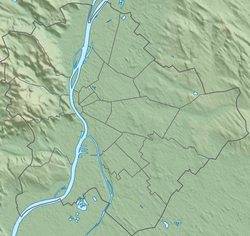Hősök tere
| Budapest, including the Banks of the Danube, the Buda Castle Quarter and Andrássy Avenue | |
|---|---|
| Name as inscribed on the World Heritage List | |

Heroes' Square – overview
|
|
| Type | Cultural |
| Criteria | ii,iv |
| Reference | 400 |
| UNESCO region | Hungary |
| Coordinates | 47°30′54″N 19°4′40″E / 47.51500°N 19.07778°ECoordinates: 47°30′54″N 19°4′40″E / 47.51500°N 19.07778°E |
| Inscription history | |
| Inscription | 2002 (26th Session) |
Hősök tere (Hungarian pronunciation: [ˈhøːʃøk ˈtɛrɛ]; English: Heroes' Square) is one of the major squares in Budapest, Hungary, noted for its iconic statue complex featuring the Seven Chieftains of the Magyars and other important national leaders, as well as the Tomb of the Unknown Soldier. The square lies at the outbound end of Andrássy Avenue next to City Park (Városliget). It hosts the Museum of Fine Arts and the Műcsarnok. The square has played an important part in contemporary Hungarian history and has been a host to many political events, such as the reburial of Imre Nagy in 1989. The sculptures were made by sculptor Zala György from Lendava.
Hősök tere is surrounded by two important buildings, Museum of Fine Arts on the left and Palace of Art (or more accurately Hall of Art) on the right. On the other side it faces Andrássy Avenue which has two buildings looking at the square — one is residential and the other one is the embassy of Serbia (former Yugoslavian embassy where Imre Nagy secured sanctuary in 1956).
The central feature of Heroes' Square, as well as a landmark of Budapest, is the Millennium Memorial (Hungarian: Millenáriumi Emlékmű, also translated Millennium Monument or Millennial Monument). Construction began in 1896 to commemorate the thousandth anniversary of the Hungarian conquest of the Carpathian Basin and the foundation of the Hungarian state in 1896, and was part of a much larger construction project which also included the expansion and refurbishing of Andrássy Avenue and the construction of the first metro line in Budapest (Hungarian: Földalatti). Construction was completed in 1900, which was when the square received its name.
...
Wikipedia

